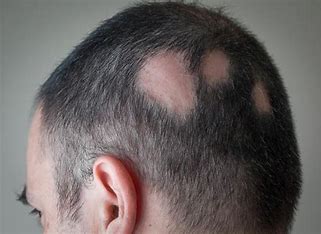Alopecia is a condition marked by hair loss on the scalp or other places of the body. It can take many different forms, each with its own set of reasons and hair loss patterns. Alopecia is categorized into two primary categories Non-scarring (reversible): Hair follicles remain intact, which may allow for hair regrowth. Scarring (irreversible): Hair follicles are damaged and replaced with scar tissue, which prevents future hair growth.
Symptoms of Alopecia
Alopecia is characterized by visible hair loss, which can develop abruptly or gradually and affect the scalp or other body parts. Symptoms include thinning hair, little round or oval bald patches, or total baldness in severe cases. Some people have diffuse shedding, with hair falling out in bigger amounts when brushing or washing. There may also be changes in scalp feeling, such as itching, burning, or tingling, when hair loss starts. Some autoimmune conditions can cause nail alterations such as pitting, ridges, or brittleness.
MUST READ;5 Ways to Treat Eczema
Causes of Alopecia According to its Types
Alopecia has a variety of causes, depending on the type. The specific etiology of alopecia areata is unknown, although it is thought to be an autoimmune illness in which the immune system erroneously assaults hair follicles, resulting in hair loss. Genetics and environmental factors may also have a role. Androgenetic alopecia, the most prevalent kind of hair loss, is caused mostly by a genetic predisposition and the effect of hormones, particularly dihydrotestosterone (DHT), which reduces hair follicles over time. Traction alopecia is caused by physical stress on the hair follicles from tight hairstyles such as braids, ponytails, or extensions, resulting in breakage and thinning. Telogen effluvium is typically caused by stress, hormonal fluctuations, sickness, or nutritional inadequacies, leading a high number of hair follicles to enter the resting phase concurrently. Alopecia totalis and universalis, the more severe variants, are thought to have autoimmune roots similar to alopecia areata but cause more widespread hair loss. Other causes that might cause hair loss include some drugs, underlying medical issues (such as thyroid disorders), and lifestyle factors.
How Alopecia is Diagnosed and Treated
Alopecia is normally diagnosed through a physical examination, a review of medical history, and, in certain cases, a biopsy or blood testing to uncover underlying disorders. The treatment for alopecia is determined by its nature and etiology. Options include topical drugs such as minoxidil, oral medications such as finasteride, corticosteroid injections for immune-related kinds, and lifestyle modifications to address triggers such as stress or nutritional deficiencies. Hair transplant surgery may be explored as a more permanent option, especially in situations with androgenetic alopecia. Supportive interventions, such as counseling and the use of wigs or scarves, can help people cope with the emotional effects of hair loss.
Summary
Alopecia is not only a physical condition; it can also have a substantial impact on an individual’s emotional and psychological well-being. Hair is frequently associated with identity and self-esteem, and rapid or progressive hair loss can trigger feelings of worry, depression, or social isolation. Understanding the underlying reasons and kinds of alopecia is critical for designing a specific treatment plan, which may include medication, lifestyle changes, or even surgical procedures. Equally crucial is the emotional support provided by counseling, support groups, and cosmetic solutions such as wigs and scarves, which can help people restore their confidence. Early diagnosis and intervention provide the best chance for effective alopecia management, and while some forms of hair loss may be permanent, current treatments nevertheless offer hope for regrowth and recovery.


